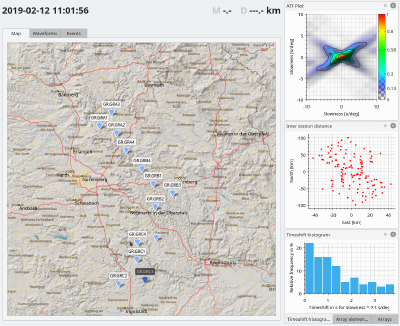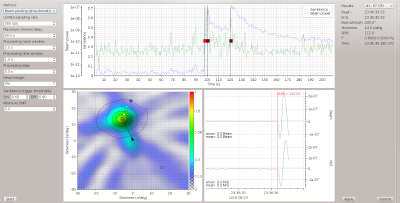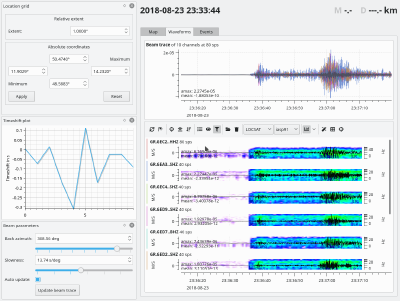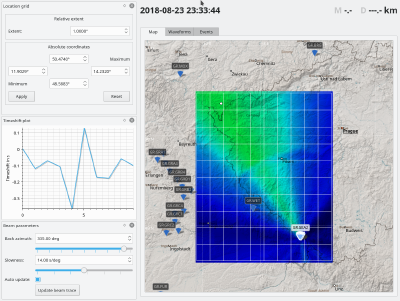LAMBDA
Seismic and infrasound events
Overview

Interactive array design allows to choose stations from maps and tables. The array characteristics are updated automatically.
Event detection by seismic and infrasound arrays
LAMBDA is gempa’s advanced seismic array processing package for detecting and locating seismic or infrasound events outside of network coverage. The package consists of an interactive and an automatic module. Both modules deliver phase picks including time, slowness and backazimuth as well as locations by slowness-azimuth beamforming or back projection. Beam packing or F-K analysis are available. Arrays can be formed interactively on a map or a table. The picks and the locations can be further processed by public SeisComP or gempa modules. For example the picks from different arrays and from just a few more stations can be combined for more reliable locations and interactively analyzed in scolv.

Seismic event detection by semblance analysis for a semblance-backazimuth grid.
Applications
- Interactive design of seismic and infrasound arrays
- Detection of earthquakes outside conventional networks
- Detection of explosions and infrasound events
- Location of seismic and infrasound events

Data can be filtered and interactively analyzed with the beam trace on top formed interactively for a set of slowness and backazimuth.
Features
- Interactive array configuration with on-the-fly computation of array parameters
- Automatic array analysis
- Interactive beam forming
- Inversion of manual phase picks for slowness and backazimuth
- F-K analysis in moving time windows
- Comparison with array response function
- Beam packing in moving time windows
- Slowness-backazimuth analysis
- Location by back projection along pre-calculated travel time curves
- Spectrogram calculation in time windows

Back projcection of waveforms is used to detect and to locate events by an array.
Technology
We take waveforms from array elements as they become available and find events hidden in the noise. By stacking of waveforms along predicted travel-time curves or a given wave number or slowness grid the signal-to-noise ratio is increased and phases with coherent amplitudes are amplified and identified. Beam parameters such as arrival times, backazimuth and slowness of the waves are calculated for these phases. For known events the data can be loaded within dynamic time windows and the predicted phase arrivals are shown. User-friendly GUIs with maps and diagrams provide full control over the data processing.
As we develop this module further more methods will be implemented in the future.
Modules
Our modules for array analysis comprise AUTOLAMBDA for automatic and LAMBDA for highly interactive data processing.
AUTOLAMBDA is processing waveforms automatically to compute the beam parameters.
LAMBDA provides operators with a user-friendly GUI and great flexibility to manually design and configure arrays and to process data from seismic and infrasound arrays.
Promotion
The LAMBDA module has been demonstrated, promoted and discussed with scientists and the SeisComP community at international science conferences, e.g.:
- D. Roessler, J. Becker, B. Weber: Array analysis for monitoring micro-seismicity and teleseismic earthquakes in SeisComP3, 2018, Washington DC, USA, AGU Fall Meeting, abstract S42C-08 .
